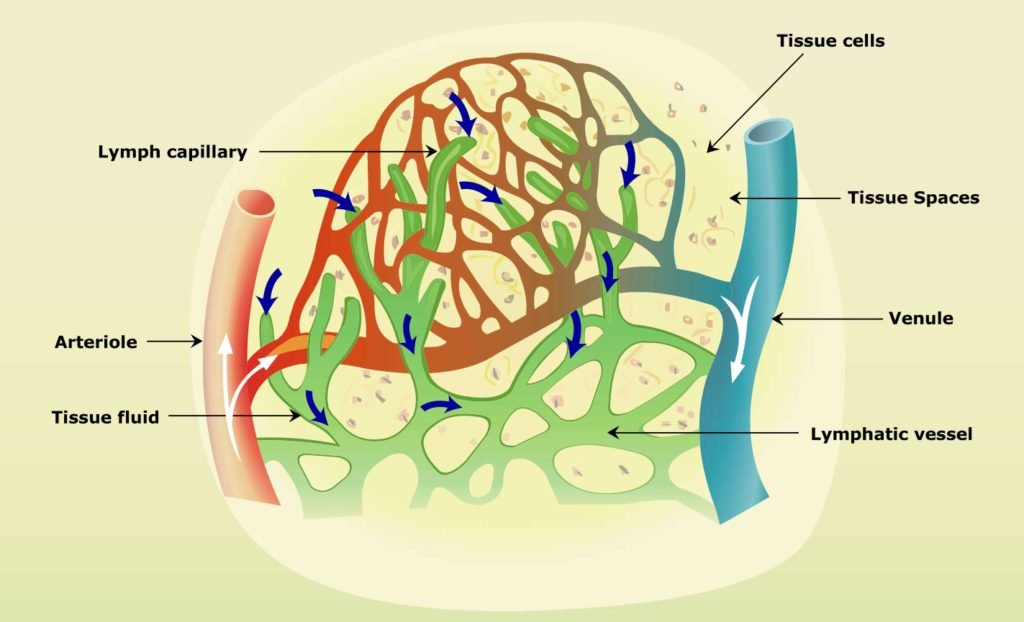TABLE OF CONTENTS
Lymph
Lymph is a clear colorless fluid somewhat similar to plasma. It is derived as a left out fluid at venous end of the capillary bed which is filtered out of the arterial end.
Lymph contains few or no RBCs, numerous leukocytes, inorganic salts, glucose, NPN substances and some proteins. Lymph derived from the intestine during absorption contains lipids which gives milky white appearance known as chyle.
Lymphatic vessels originate as blind lymphatic capillaries in between the tissues to collect the tissue fluids, which are not absorbed by the venous system. Lymph capillaries are highly permeable and have less resistance to the entry of macromolecule proteins.
The lymphatic capillaries form a complex network throughout the tissues and combine to form small lymphatic vessels. This in turn unites to form large lymphatic vessels.
All the lymphatic vessels of the left side of head, arm and chest and the posterior portion of the body drain their lymph into the thoracic duct, whereas the right lymphatic duct receives the lymph from the right side of the head, neck, foreleg and thorax.
These two lymphatic vessels empty their contents into the venous system at the juncture of the right subclavian vein and internal jugular vein.
Lymphatic vessels resemble veins, but their walls are much thinner than veins. They have valves throughout their course to direct the lymph flow towards heart and prevent back flow of lymph.
Lymph glands or nodes are discrete nodular structures scattered along the course of lymphatic vessels. These nodes function as filters to foreign agents (bacteria).

Lymphatic glands have lymphocytes and plasma cells, produce antibodies and macrophages against foreign invaders, thus act as a first line of defense organ against infective organisms. Lymph nodes are absent in brain, bone marrow and also in birds.
Functions of Lymph
The lymph helps in the reabsorption of the fluid from the tissue spaces and adds it to the circulatory system, thus maintains a constant fluid equilibrium. It filters the harmful infectious agents (bacteria) from the body.
It absorbs and transports the fatty substances from the intestine in the form of chyle. It helps in the absorption of macromolecular proteins from the interstitial spaces, which are then added to the blood.
Formation of Lymph
At venous capillary end, only about 90% of the fluid portion of plasma that comes out from the capillary bed of the blood vessels is reabsorbed due to pressure gradient. The remaining 10% constitute the lymph which enters the lymph channels and return to the circulatory system.
The movement of the lymph inside the vessel is caused by the pressure difference between two ends of the lymphatic system, contractions of the muscles during movement of the body, contractions of the smooth muscles of the lymphatic vessels and presence of valves which prevent back flow.
Forces causing filtration (at the atrial end)
- Forces tending to move fluid outward
- Capillary pressure : 30.0 mm Hg
- Negative pressure of interstitial fluid : 3.0 mm Hg
- I.F. colloidal osmotic pressure : 8.0 mm Hg
- Total outward force : 41.0 mm Hg
- Forces tending to move fluid inward
- Plasma colloidal osmotic pressure : 28.0 mm Hg
- Net filtration pressure = Out pressure – In ward pressure
- 41.0 – 28.0 = 13.0 mm Hg.
Force causing reabsorption (At the venous end)
- Forces tending to move fluid outward
- Capillary pressure : 10.0 mm Hg
- Negative pressure of interstitial fluid : 3.0 mm Hg
- I.F colloidal osmotic pressure : 8.0 mm Hg
- Total outward force : 21.0 mm Hg
- Forces tending to move fluid inward
- Plasma colloidal osmotic pressure : 28.0 mm Hg
- Net absorption pressure = Inward pressure – Outward pressure
- 28.0 – 21.0 = 7.0 mm Hg.
Factors determining fluid movement across the capillary wall
Capillary pressure or capillary hydrostatic pressure tends to move fluid outward.
Interstitial fluid pressure tends to move fluid inward when it is positive and outward when it is negative.
Plasma colloid osmotic pressure (Oncotic pressure) tends to cause osmosis of fluid inward.
Interstitial fluid colloid osmotic pressure tend to cause osmosis of fluid outward.